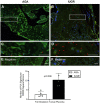Increased Colocalization and Interaction Between Decidual Protein Kinase A and Insulin-like Growth Factor-Binding Protein-1 in Intrauterine Growth Restriction
- PMID: 35801847
- PMCID: PMC9284236
- DOI: 10.1369/00221554221112702
Increased Colocalization and Interaction Between Decidual Protein Kinase A and Insulin-like Growth Factor-Binding Protein-1 in Intrauterine Growth Restriction
Abstract
Increased phosphorylation of decidual insulin-like growth factor-binding protein-1 (IGFBP-1) can contribute to intrauterine growth restriction (IUGR) by decreasing the bioavailability of insulin-like growth factor-1 (IGF-1). However, the molecular mechanisms regulating IGFBP-1 phosphorylation at the maternal-fetal interface are poorly understood. Protein kinase A (PKA) is required for normal decidualization. Consensus sequences for PKA are present in IGFBP-1. We hypothesized that the expression/interaction of PKA with decidual IGFBP-1 is increased in IUGR. Parallel reaction monitoring-mass spectrometry (PRM-MS) identified multiple PKA peptides (n=>30) co-immunoprecipitating with IGFBP-1 in decidualized primary human endometrial stromal cells (HESC). PRM-MS also detected active PKApThr197 and greater site-specific IGFBP-1 phosphorylation(pSer119), (pSer98+pSer101) (pSer169+pSer174) in response to hypoxia. Hypoxia promoted colocalization [dual immunofluorescence (IF)] of PKA with IGFBP-1 in decidualized HESC. Colocalization (IF) and interaction (proximity ligation assay) of PKA and IGFBP-1 were increased in decidua collected from placenta of human IUGR pregnancies (n=8) compared with decidua from pregnancies with normal fetal growth. Similar changes were detected in decidual PKA/IGFBP-1 using placenta from baboons subjected to maternal nutrient reduction (MNR) vs controls (n=3 each). In baboons, these effects were evident in MNR at gestational day 120 prior to IUGR onset. Increased PKA-mediated phosphorylation of decidual IGFBP-1 may contribute to decreased IGF-1 bioavailability in the maternal-fetal interface in IUGR.
Keywords: fluorescent antibody technique; humans; hypoxia; mass spectrometry; maternal; nutrient reduction; papio; placenta; stromal cells.
Conflict of interest statement
Figures











Similar articles
-
Increased Insulin-like Growth Factor Binding Protein-1 Phosphorylation in Decidualized Stromal Mesenchymal Cells in Human Intrauterine Growth Restriction Placentas.J Histochem Cytochem. 2018 Sep;66(9):617-630. doi: 10.1369/0022155418772574. Epub 2018 May 2. J Histochem Cytochem. 2018. PMID: 29718759 Free PMC article.
-
Mechanistic Target of Rapamycin Complex 1 Signaling Links Hypoxia to Increased IGFBP-1 Phosphorylation in Primary Human Decidualized Endometrial Stromal Cells.Biomolecules. 2021 Sep 18;11(9):1382. doi: 10.3390/biom11091382. Biomolecules. 2021. PMID: 34572595 Free PMC article.
-
Exposure of decidualized HIESC to low oxygen tension and leucine deprivation results in increased IGFBP-1 phosphorylation and reduced IGF-I bioactivity.Mol Cell Endocrinol. 2017 Sep 5;452:1-14. doi: 10.1016/j.mce.2017.04.005. Epub 2017 Apr 21. Mol Cell Endocrinol. 2017. PMID: 28435049 Free PMC article.
-
Insulin-like growth factor binding protein-1: recent findings and new directions.Proc Soc Exp Biol Med. 1997 Dec;216(3):319-57. doi: 10.3181/00379727-216-44182. Proc Soc Exp Biol Med. 1997. PMID: 9402139 Review.
-
Insulin-like growth factors and insulin-like growth factor binding proteins in the endometrium. Effect of intrauterine levonorgestrel delivery.Hum Reprod. 2000 Aug;15 Suppl 3:173-81. doi: 10.1093/humrep/15.suppl_3.173. Hum Reprod. 2000. PMID: 11041233 Review.
Cited by
-
Regulation and function of insulin and insulin-like growth factor receptor signalling.Nat Rev Mol Cell Biol. 2025 Jul;26(7):558-580. doi: 10.1038/s41580-025-00826-3. Epub 2025 Feb 10. Nat Rev Mol Cell Biol. 2025. PMID: 39930003 Review.
References
-
- Gibson JM, Aplin JD, White A, Westwood M. Regulation of IGF bioavailability in pregnancy. Mol Hum Reprod. 2001;7(1):79–87. - PubMed
-
- Clemmons DR. IGF binding proteins and their functions. Mol Reprod Dev. 1993;35(4):368–74. - PubMed
-
- Martina NA, Kim E, Chitkara U, Wathen NC, Chard T, Giudice LC. Gestational age-dependent expression of insulin-like growth factor-binding protein-1 (IGFBP-1) phosphoisoforms in human extraembryonic cavities, maternal serum, and decidua suggests decidua as the primary source of IGFBP-1 in these fluids during early pregnancy. J Clin Endocrinol Metab. 1997;82(6):1894–8. - PubMed
-
- Westwood M, Gibson JM, Davies AJ, Young RJ, White A. The phosphorylation pattern of insulin-like growth factor-binding protein-1 in normal plasma is different from that in amniotic fluid and changes during pregnancy. J Clin Endocrinol Metab. 1994;79(6):1735–41. - PubMed
Publication types
MeSH terms
Substances
Grants and funding
LinkOut - more resources
Full Text Sources
Research Materials
Miscellaneous

